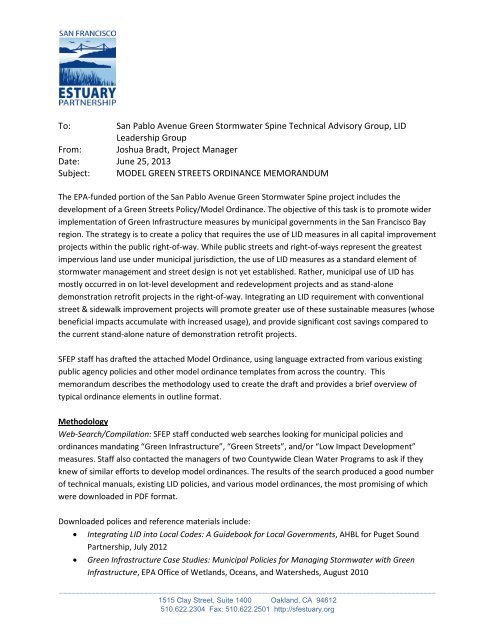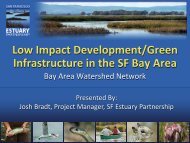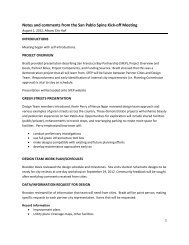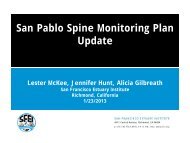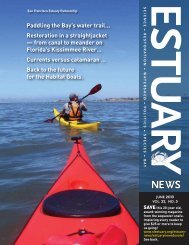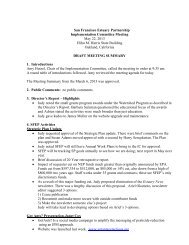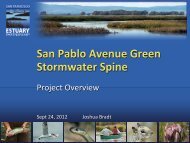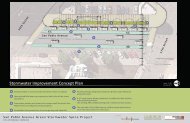Memo and Draft Model Green Streets Ordinance - San Francisco ...
Memo and Draft Model Green Streets Ordinance - San Francisco ...
Memo and Draft Model Green Streets Ordinance - San Francisco ...
Create successful ePaper yourself
Turn your PDF publications into a flip-book with our unique Google optimized e-Paper software.
To:<br />
<strong>San</strong> Pablo Avenue <strong>Green</strong> Stormwater Spine Technical Advisory Group, LID<br />
Leadership Group<br />
From: Joshua Bradt, Project Manager<br />
Date: June 25, 2013<br />
Subject: MODEL GREEN STREETS ORDINANCE MEMORANDUM<br />
The EPA-funded portion of the <strong>San</strong> Pablo Avenue <strong>Green</strong> Stormwater Spine project includes the<br />
development of a <strong>Green</strong> <strong>Streets</strong> Policy/<strong>Model</strong> <strong>Ordinance</strong>. The objective of this task is to promote wider<br />
implementation of <strong>Green</strong> Infrastructure measures by municipal governments in the <strong>San</strong> <strong>Francisco</strong> Bay<br />
region. The strategy is to create a policy that requires the use of LID measures in all capital improvement<br />
projects within the public right-of-way. While public streets <strong>and</strong> right-of-ways represent the greatest<br />
impervious l<strong>and</strong> use under municipal jurisdiction, the use of LID measures as a st<strong>and</strong>ard element of<br />
stormwater management <strong>and</strong> street design is not yet established. Rather, municipal use of LID has<br />
mostly occurred in on lot-level development <strong>and</strong> redevelopment projects <strong>and</strong> as st<strong>and</strong>-alone<br />
demonstration retrofit projects in the right-of-way. Integrating an LID requirement with conventional<br />
street & sidewalk improvement projects will promote greater use of these sustainable measures (whose<br />
beneficial impacts accumulate with increased usage), <strong>and</strong> provide significant cost savings compared to<br />
the current st<strong>and</strong>-alone nature of demonstration retrofit projects.<br />
SFEP staff has drafted the attached <strong>Model</strong> <strong>Ordinance</strong>, using language extracted from various existing<br />
public agency policies <strong>and</strong> other model ordinance templates from across the country. This<br />
memor<strong>and</strong>um describes the methodology used to create the draft <strong>and</strong> provides a brief overview of<br />
typical ordinance elements in outline format.<br />
Methodology<br />
Web-Search/Compilation: SFEP staff conducted web searches looking for municipal policies <strong>and</strong><br />
ordinances m<strong>and</strong>ating “<strong>Green</strong> Infrastructure”, “<strong>Green</strong> <strong>Streets</strong>”, <strong>and</strong>/or “Low Impact Development”<br />
measures. Staff also contacted the managers of two Countywide Clean Water Programs to ask if they<br />
knew of similar efforts to develop model ordinances. The results of the search produced a good number<br />
of technical manuals, existing LID policies, <strong>and</strong> various model ordinances, the most promising of which<br />
were downloaded in PDF format.<br />
Downloaded polices <strong>and</strong> reference materials include:<br />
• Integrating LID into Local Codes: A Guidebook for Local Governments, AHBL for Puget Sound<br />
Partnership, July 2012<br />
• <strong>Green</strong> Infrastructure Case Studies: Municipal Policies for Managing Stormwater with <strong>Green</strong><br />
Infrastructure, EPA Office of Wetl<strong>and</strong>s, Oceans, <strong>and</strong> Watersheds, August 2010<br />
_____________________________________________________________________________________________<br />
1515 Clay Street, Suite 1400 Oakl<strong>and</strong>, CA 94612<br />
510.622.2304 Fax: 510.622.2501 http://sfestuary.org
• Incorporating Low Impact Development into Municipal Stormwater Programs Fact Sheet, EPA,<br />
April 2009<br />
• Missouri Guide to <strong>Green</strong> Infrastructure: Integrating Water Quality into Municipal Stormwater<br />
Management, Missouri Department of Natural Resources, May 2012<br />
• A Low Impact Development (LID) <strong>Model</strong> <strong>Ordinance</strong> <strong>and</strong> Guidance Document (presentation for<br />
Philadelphia LID Symposium), Trinkaus Engineering/Ecosite, Inc., 2011<br />
• Smart Growth/Smart Energy Tool Kit: <strong>Model</strong> LID By-Law, Commonwealth of Massachusetts, no<br />
date<br />
• LID Manual for Michigan: A Design Guide for Implementers <strong>and</strong> Reviewers, Southeast Michigan<br />
Council of Governments Information Center, 2008<br />
• Innovative L<strong>and</strong> Use Planning Techniques: A H<strong>and</strong>book for Sustainable Development, New<br />
Hampshire Department of Environment Services, October 2008<br />
• Permitting <strong>Green</strong> Infrastructure: A Guide to Improving Municipal Stormwater Permits <strong>and</strong><br />
Protecting Water Quality, Jeffrey Odefey for American Rivers, January 2013<br />
• Urban Forestry Best Management Practices for Public Works Managers: <strong>Ordinance</strong>s, Regulators,<br />
<strong>and</strong> Public Policies Report, APWA Press, no date<br />
• <strong>Green</strong> Infrastructure for Los Angeles: Addressing Urban Runoff <strong>and</strong> Water Supply through Low<br />
Impact Development, City of Los Angeles, April 2009<br />
• <strong>Green</strong> City Clean Waters: Program for Combined Sewer Overflow, Philadelphia Water<br />
Department, June 2011<br />
• Complete <strong>and</strong> <strong>Green</strong> <strong>Streets</strong> Policy (<strong>Ordinance</strong> No. 798-11), City of Clevel<strong>and</strong>, 2012<br />
• Low Impact Development St<strong>and</strong>ards <strong>Ordinance</strong> (No. 2008-0063), County of Los Angeles, 2008<br />
• Drought-Tolerant L<strong>and</strong>scaping Requirement <strong>Ordinance</strong> (No. 2008-0064), County of Los Angeles,<br />
2008<br />
• <strong>Green</strong> <strong>Streets</strong>: Design Guidelines <strong>and</strong> Review Process (SDOT Director’s Rule 2-07, DPD<br />
Director’s Rule 11-2007), City of Seattle, 2007<br />
• LID Amendments to Los Angeles Municipal Code (amending various municipal codes), City of Los<br />
Angeles, 2011<br />
• <strong>Green</strong> <strong>Streets</strong> Resolution, City of Portl<strong>and</strong>, 2007<br />
• Exhibit A: <strong>Green</strong> <strong>Streets</strong> Policy, City of Portl<strong>and</strong>, 2007<br />
• <strong>San</strong> <strong>Francisco</strong> Better <strong>Streets</strong> Plan Implementation <strong>Ordinance</strong> (amending various municipal<br />
codes), City <strong>and</strong> County of <strong>San</strong> <strong>Francisco</strong>, 2010<br />
• Development St<strong>and</strong>ards Plan: Low Impact Development Designs <strong>and</strong> Practices for Urban Storm<br />
Drainage Management, City of Salinas, July 2007<br />
Analyses of Materials: SFEP staff reviewed the downloaded documents to determine which of the<br />
policies were most compatible with the objective. Most of the policies <strong>and</strong> stormwater management<br />
plans focused on LID requirements for new <strong>and</strong> redevelopment projects in relation to area <strong>and</strong><br />
impervious surface change criterion. In the Bay Area, Provision C3 of the Municipal Regional Permit<br />
already m<strong>and</strong>ates these measures, which are presumably enforced by Bay Area municipal governments.<br />
Otherwise, the existing LID policies specific to the public realm most often appeared in cities with<br />
combined sewer stormwater <strong>and</strong> sanitary sewer systems (i.e. Portl<strong>and</strong>, Seattle, Philadelphia, <strong>and</strong> <strong>San</strong>
<strong>Francisco</strong>). These municipalities are particularly interested in LID measures as a means of reducing<br />
stormwater runoff volumes which exacerbate combined sewer overflows. The majority of cities with LID<br />
policies for the public realm also had attendant stormwater, watershed, or street-improvement<br />
management plans or guidelines already in place.<br />
<strong>Model</strong> <strong>Ordinance</strong> Structure & Elements: Staff reviewed both the above referenced materials as well as<br />
general municipal code structures <strong>and</strong> language to develop the draft model ordinance outlined below.<br />
The bolded materials listed above were the primary documents used to develop the model ordinance<br />
language. In the writing of the model ordinance, staff kept a few critical pointers in mind:<br />
• Keep ordinance simple, direct & underst<strong>and</strong>able<br />
• Complicated ordinances hard to enforce, lead to disregard<br />
• Provide provisions in text that will draw on other sources of expertise in evaluating applications<br />
beyond municipal staff (Conservation Districts, State departments: Caltrans, etc.)<br />
ORDINANCE ELEMENTS (DRAFT OUTLINE)<br />
1. TITLE<br />
2. FINDINGS<br />
a. Outline why ordinance is necessary<br />
b. Summarize function <strong>and</strong> benefit of green stormwater treatment facilities<br />
c. Summarize economic, sustainable, social, environmental benefits of green<br />
streets<br />
3. PURPOSE<br />
a. Function <strong>and</strong> objective of ordinance<br />
4. DEFINITIONS & ABBREVIATIONS<br />
a. More definition = less “gray areas” for subjective interpretation & higher<br />
program success<br />
5. APPLICABILITY<br />
a. Establish what portion or portions of l<strong>and</strong>s the ordinance will apply to<br />
b. Options for defining l<strong>and</strong>s include specific areas (set distance) or variable areas<br />
c. Who must abide by ordinance<br />
d. Circumstantial criteria<br />
e. Exemptions<br />
6. REGULATED ACTIVITIES<br />
a. Establish what activities are permitted (by right) <strong>and</strong> which will require further<br />
review <strong>and</strong>/or permitting<br />
b. Means must be outlined to provide for uses not specifically y listed (who<br />
determines, who enforces)<br />
7. ENFORCEMENT<br />
a. A procedure must be established for fines & penalties (if ordinance is violated)<br />
8. LOW IMPACT DESIGN STANDARDS
DRAFT MODEL GREEN STREETS ORDINANCE<br />
<strong>San</strong> <strong>Francisco</strong> Estuary Partnership<br />
DRAFT <strong>Model</strong> <strong>Green</strong> <strong>Streets</strong> <strong>Ordinance</strong><br />
ARTICLE I. TITLE, FINDINGS, PURPOSE<br />
Section 1.01 Title<br />
This ordinance shall be known as the “ <strong>Green</strong> <strong>Streets</strong> <strong>Ordinance</strong>” <strong>and</strong> may be<br />
so cited.<br />
Section 1.02 Findings<br />
finds that:<br />
• L<strong>and</strong> development, including its attendant roadways <strong>and</strong> sidewalks, results in increased<br />
impervious cover in local watersheds which alter natural hydrologic responses<br />
contributing to: increased storm water runoff rates <strong>and</strong> volumes, increased flooding,<br />
accelerated erosion of stream channels, increased sediment transport <strong>and</strong> deposition,<br />
<strong>and</strong> increased nonpoint source pollutant loading to receiving water bodies <strong>and</strong> the <strong>San</strong><br />
<strong>Francisco</strong> Bay.<br />
• is required by state <strong>and</strong> federal government through its National<br />
Pollutant Discharge Elimination System (NPDES) Permit (NPDES Permit No. CA0049981,<br />
Regional Board Order No. R3-2004-0135) to reduce stormwater pollution, protect<br />
groundwater, <strong>and</strong> develop <strong>and</strong> manage programs that respond to water quality<br />
requirements.<br />
• The public right-of-way constitutes a significant proportion of the impervious cover<br />
within the City boundary, contributing greatly to stormwater runoff volumes, rates, <strong>and</strong><br />
non-point source pollutants.<br />
• Paved space on many of the City’s streets is more than is needed for the safe <strong>and</strong><br />
efficient movement of transit, bicycles, <strong>and</strong> automobiles.<br />
• Low Impact Development (LID) is an emerging strategy that emphasizes conservation<br />
<strong>and</strong> the use of distributed small-scale stormwater controls to mimic pre-development<br />
hydrology to mitigate the negative impacts of development <strong>and</strong> urbanization. LID<br />
measures include the use of open-space preservation, vegetation <strong>and</strong> l<strong>and</strong>scaping,<br />
rainwater harvesting, <strong>and</strong> permeable surfaces to capture, detain, filter, <strong>and</strong> infiltrate<br />
stormwater runoff.<br />
• <strong>Green</strong> <strong>Streets</strong> (streets designed with the use of LID measures) are recognized as an<br />
effective way to reduce impacts from urbanization <strong>and</strong> provide the benefits of:<br />
o Replenishing groundwater supplies<br />
o Improving the quality of surface water runoff<br />
o Stabilizing natural stream characteristics<br />
o Reducing stormwater runoff peak volumes <strong>and</strong> local flooding<br />
o Increasing open space <strong>and</strong> park-like features<br />
o Increasing pedestrian safety <strong>and</strong> community livability.<br />
1
DRAFT MODEL GREEN STREETS ORDINANCE<br />
<strong>San</strong> <strong>Francisco</strong> Estuary Partnership<br />
• <strong>Green</strong> <strong>Streets</strong> can provide cost-effective solutions to stormwater management when<br />
practiced at a watershed scale, such that LID facilities can cumulatively reduce runoff<br />
volumes to the extent that the need to enlarge existing piped infrastructure is off-set.<br />
• <strong>Green</strong> <strong>Streets</strong> approaches foster unique <strong>and</strong> attractive streetscapes that protect <strong>and</strong><br />
enhance neighborhood livability <strong>and</strong> integrate, rather than separate, the built <strong>and</strong><br />
natural environments.<br />
• <strong>Green</strong> <strong>Streets</strong> approaches encourage the planting of l<strong>and</strong>scapes <strong>and</strong> vegetation. City<br />
l<strong>and</strong>scapes <strong>and</strong> trees contribute environmental benefits such as reduced summer air<br />
temperatures, reductions in global warming through carbon sequestration, air pollution<br />
screening, <strong>and</strong> wildlife corridors, in addition to stormwater reduction.<br />
• When planned on a neighborhood scale, <strong>Green</strong> <strong>Streets</strong> can serve as urban greenways or<br />
pathways <strong>and</strong> provide a preferred means of connecting neighborhoods <strong>and</strong><br />
parks/recreation areas in ways that are attractive to pedestrians <strong>and</strong> bicyclists.<br />
• <strong>Streets</strong> that support <strong>and</strong> invite multiple uses, including safe, active, <strong>and</strong> ample space for<br />
pedestrians, bicycles, <strong>and</strong> public transit, are more conducive to the public life of an<br />
urban neighborhood <strong>and</strong> efficient movement of people <strong>and</strong> goods than streets designed<br />
primarily to move automobiles.<br />
• Decisions regarding the design <strong>and</strong> use of the City’s limited public street space should<br />
prioritize space for pedestrians, bicycles, <strong>and</strong> public transit over space for automobiles.<br />
• Adopting <strong>and</strong> implementing the st<strong>and</strong>ards, criteria, <strong>and</strong> procedures contained in this<br />
ordinance (<strong>and</strong> to be further developed) will significantly reduce many of the<br />
deleterious effects of stormwater runoff <strong>and</strong> contribute to the protection <strong>and</strong><br />
preservation of the public health, safety, <strong>and</strong> welfare <strong>and</strong> to protect natural resources<br />
Section 1.03 Purpose<br />
It is the purpose of this ordinance to establish minimum requirements for planning, designing,<br />
implementing <strong>and</strong> maintaining LID facilities as a st<strong>and</strong>ard element of public right of way<br />
improvements. The <strong>Green</strong> <strong>Streets</strong> <strong>Ordinance</strong> m<strong>and</strong>ates the use of street/sidewalk best<br />
management practices that incorporate sustainable water management techniques. These<br />
measures when integrated with pedestrian-oriented <strong>and</strong> multi-modal street elements will<br />
improve the quality of life, economic well-being, <strong>and</strong> environmental health in .<br />
This ordinance seeks to meet that purpose through the following objectives:<br />
o Minimize storm water runoff generated by the public right-of-way in order to reduce<br />
flooding, siltation, in-stream water temperatures, <strong>and</strong> accelerated erosion of natural<br />
channels;<br />
o Maintain the ecological integrity of stream channels (<strong>and</strong> the <strong>San</strong> <strong>Francisco</strong> Bay);<br />
o Minimize discharges of nonpoint source pollution caused by storm water runoff from<br />
the public right-of-way which otherwise degrade local water quality;<br />
2
DRAFT MODEL GREEN STREETS ORDINANCE<br />
<strong>San</strong> <strong>Francisco</strong> Estuary Partnership<br />
o Minimize the total annual volume of surface water runoff which flows from the public<br />
right-of-way or City-funded development projects to not exceed the pre-development<br />
hydrologic regime to the maximum extent practicable;<br />
o Ensure management controls are properly maintained <strong>and</strong> pose no threat to public<br />
safety;<br />
o Meet the requirements of its National Pollutant Discharge Elimination System (NPDES)<br />
Permit (NPDES Permit No. CA0049981, Regional Board Order No. R3-2004-0135-update<br />
to MRP) that allows the discharge of storm water from the municipal separate storm<br />
sewer systems.<br />
In furtherance of the <strong>Green</strong> <strong>Streets</strong> <strong>Ordinance</strong>, the City recognizes that its streets constitute a<br />
large portion of the City’s public space. Implementation of the <strong>Green</strong> <strong>Streets</strong> <strong>Ordinance</strong> will<br />
ensure that such streets will continue to be:<br />
o Corridors for various modes of transportation, with a particular emphasis on pedestrians<br />
<strong>and</strong> transit priorities;<br />
o Organizers of the City’s development pattern <strong>and</strong> how individuals perceive such a<br />
pattern; <strong>and</strong><br />
o An integral component of City’s stormwater management infrastructure.<br />
ARTICLE II: DEFINITIONS & ABBREVIATIONS<br />
Section 2.01 Definition of Terms<br />
The following terms, phrases, words <strong>and</strong> derivatives shall have the meaning defined below:<br />
1. “Accelerated Erosion” means erosion caused by development activities that exceeds the natural<br />
processes by which the surface of the l<strong>and</strong> is worn away by the action of water, wind, or<br />
chemical action.<br />
2. “Best Management Practice” means any kind of procedure, facility, feature, control or device<br />
designed to minimize the quantity of pollutants that enter the stormwater drainage<br />
infrastructure.<br />
3. “Channel” means a natural or artificial watercourse with a definite bed <strong>and</strong> banks that conducts<br />
continuously or periodically flowing water.<br />
4. “Detention" means the temporary storage of storm runoff in a storm water management<br />
practice with the goals of controlling peak discharge rates <strong>and</strong> providing gravity settling of<br />
pollutants.<br />
5. “Flow-based Treatment Control BMPs” means structural treatment controls designed to<br />
convey, treat or infiltrate the maximum flow rate produced by a rain event equal to two times<br />
the 85th percentile hourly rainfall intensity based on local rainfall records. Examples of flowbased<br />
treatment control BMPs include vegetated swales <strong>and</strong> buffer strips.<br />
6. “<strong>Green</strong> Infrastructure” means the use of Low Impact Development measures in the public rightof-way<br />
or in open space areas.<br />
7. “<strong>Green</strong> Street” means the use of Low Impact Development features to retrofit public streets<br />
<strong>and</strong> sidewalks.<br />
3
DRAFT MODEL GREEN STREETS ORDINANCE<br />
<strong>San</strong> <strong>Francisco</strong> Estuary Partnership<br />
8. “Hotspot” means an area where l<strong>and</strong> use or activities generate highly contaminated runoff, with<br />
concentrations of pollutants in excess of those typically found in storm water.<br />
9. “Hydrologic Soil Group (HSG)” means a Natural Resource Conservation Service classification<br />
system in which soils are categorized into four runoff potential groups. The groups range from A<br />
soils, with high permeability <strong>and</strong> little runoff production, to D soils, which have low permeability<br />
rates <strong>and</strong> produce much more runoff.<br />
10. “Impervious Cover” means those man-made or modified surfaces that prevents or substantially<br />
reduces the entry of water into the underlying soil (e.g., building rooftops, pavement, sidewalks,<br />
driveways, etc), resulting in surface runoff in greater quantities <strong>and</strong>/or at an increased rate<br />
relative to pre-development conditions.<br />
11. “Infiltration” means the process of percolating storm water into the subsoil.<br />
12. “L<strong>and</strong> Disturbance Activity” means any activity which changes the volume or peak flow<br />
discharge rate of rainfall runoff from the l<strong>and</strong> surface. This may include the grading, digging,<br />
cutting, scraping, or excavating of soil, placement of fill materials, paving, construction,<br />
substantial removal of vegetation, or any activity which bares soil or rock or involves the<br />
diversion or piping of any natural or man-made watercourse.<br />
13. “Low Impact Development (LID)” means the principles <strong>and</strong> techniques used in designing sites<br />
(starting from site layout, <strong>and</strong> grading <strong>and</strong> compaction phases of construction) that disturb only<br />
the smallest area necessary, minimize soil compaction <strong>and</strong> imperviousness, preserve natural<br />
drainages, vegetation, <strong>and</strong> buffer zones, <strong>and</strong> utilize on-site, lot sized storm water treatment<br />
techniques. LID sites reduce <strong>and</strong> compensate for development’s impact(s) on hydrology <strong>and</strong><br />
water quality.<br />
14. “Maximum Extent Practicable (MEP)” is generally a result of emphasizing pollution prevention<br />
<strong>and</strong> source control best management practices (BMPs) as the first lines of defense in<br />
combination with structural treatment control BMPs where appropriate serving as additional<br />
lines of defense. The MEP approach is an ever evolving, flexible, <strong>and</strong> advancing concept, which<br />
considers technical <strong>and</strong> economic feasibility. MEP is defined by what is required in the NPDES<br />
Permit, EPA guidance, <strong>and</strong> current applied <strong>and</strong> available methods <strong>and</strong> financially feasible<br />
technology.<br />
15. “Nonpoint Source Pollution” means pollution from any source other than from any discernible,<br />
confined, <strong>and</strong> discrete conveyances, <strong>and</strong> shall include, but not be limited to, pollutants from<br />
agricultural, silvicultural, mining, construction, subsurface disposal <strong>and</strong> urban runoff sources.<br />
16. “Off-Site Facility” means a storm water management measure located outside the subject<br />
property boundary described in the permit application for l<strong>and</strong> development activity.<br />
17. “On-Site Facility” means a storm water management measure located within the subject<br />
property boundary described in the permit application for l<strong>and</strong> development activity.<br />
18. “Recharge” means the replenishment of underground water reserves.<br />
19. “Storm Water Management” means the use of structural or non-structural practices that are<br />
designed to reduce storm water runoff pollutant loads, discharge volumes, peak flow discharge<br />
rates <strong>and</strong> detrimental changes in stream temperature that affect water quality <strong>and</strong> habitat.<br />
20. "Storm Water Runoff" means flow on the surface of the ground, resulting from precipitation.<br />
21. “Storm Water Treatment Practices (STPs)” means measures, either structural or nonstructural,<br />
that are determined to be the most effective, practical means of preventing or reducing point<br />
source or nonpoint source pollution inputs to storm water runoff <strong>and</strong> waterbodies.<br />
22. “Volume-based Treatment Control BMPs” means structural treatment controls designed to<br />
capture, treat or infiltrate the volume produced by the local 24-hour, 85th percentile storm<br />
event or 80% of the volume of annual runoff. Examples of volume-based treatment control<br />
4
DRAFT MODEL GREEN STREETS ORDINANCE<br />
<strong>San</strong> <strong>Francisco</strong> Estuary Partnership<br />
BMPs include extended detention basins, infiltration basins <strong>and</strong> trenches, <strong>and</strong> bioretention<br />
basins. Numerically the volume will vary as a function of geographic location <strong>and</strong> long term<br />
rainfall statistical data.<br />
23. “Urban Runoff” means surface water flow produced by storm <strong>and</strong> non-storm events, including<br />
flow from residential, commercial, or industrial activities involving the use of potable <strong>and</strong> nonpotable<br />
water.<br />
Section 2.02 Acronyms <strong>and</strong> Abbreviations<br />
The following acronyms <strong>and</strong> abbreviations shall represent the agencies, organizations,<br />
practices, <strong>and</strong> terms listed below:<br />
BASMAA<br />
CASQA<br />
Caltrans<br />
GI<br />
LID<br />
BMP<br />
EPA<br />
MRP<br />
NPDES<br />
MEP<br />
Bay Area Stormwater Management Agencies Association<br />
California Stormwater Quality Association<br />
California Department of Transportation<br />
<strong>Green</strong> Infrastructure<br />
Low Impact Development<br />
Best Management Practice<br />
Environmental Protection Agency<br />
Municipal Regional Permit<br />
National Pollutant Discharge Elimination System<br />
Maximum Extent Practicable<br />
ARTICLE III. GENERAL PROVISIONS<br />
Section 3.01 Applicability<br />
Whenever the City of undertakes a capital improvement project involving<br />
the planning, construction, reconstruction, or repaving of a public right-of-way, such project<br />
shall include the incorporation of Low Impact Development (LID) stormwater facilities, to the<br />
maximum extent practicable <strong>and</strong> feasible. The ordinance requirement shall also apply to all<br />
such privately-funded improvement projects to the public right-of-way. For the purpose of<br />
compliance with this ordinance, the term “public right-of-way” shall be understood to include<br />
all publically-owned:<br />
• streets<br />
• roads<br />
• highways<br />
• sidewalks<br />
• alleyways<br />
• public spaces<br />
Emergency maintenance <strong>and</strong> repair projects are exempt from the LID requirements as are other<br />
circumstances detailed in Section 3.03 of this ordinance.<br />
5
DRAFT MODEL GREEN STREETS ORDINANCE<br />
<strong>San</strong> <strong>Francisco</strong> Estuary Partnership<br />
Section 3.02 Maintenance<br />
All projects governed by the <strong>Green</strong> <strong>Streets</strong> <strong>Ordinance</strong> shall include provisions for ongoing<br />
maintenance of the improvements. The City shall establish a level of service for the routine, ongoing<br />
operations <strong>and</strong> maintenance needs of all LID facilities within the public right-of-way to<br />
ensure long-term proper functioning. Supplemental maintenance arrangements may be utilized<br />
to reduce the costs to the City for ongoing maintenance, such as maintenance agreements with<br />
willing adjacent property owners, volunteer stewardship organizations, <strong>and</strong>/or private<br />
developer entities who have used the off-site LID option to fund or implement LID treatment in<br />
the public right-of-way.<br />
Section 3.03 Limitations <strong>and</strong> Exemptions<br />
This section describes the Limitations of implementing this <strong>Ordinance</strong> in certain circumstances<br />
as well as Exemptions to the <strong>Ordinance</strong>:<br />
A. Limitations<br />
1. Street <strong>and</strong> Road Resurfacing Projects – <strong>Green</strong> <strong>Streets</strong> measures on street <strong>and</strong> road<br />
resurfacing projects <strong>and</strong> other roadway maintenance projects conducted by shall be limited to minimal LID improvements that do not require<br />
disturbance to the sub base, curbs <strong>and</strong> sidewalks or other elements outside the<br />
scope of a project of maintenance resurfacing. This may include the use of<br />
permeable paving. If no LID measure is feasible within the resurfacing project area,<br />
then the City shall identify an off-site LID opportunity area within the public right-ofway<br />
<strong>and</strong> apply 5% of the resurfacing project cost towards the identified off-site<br />
project. The City may aggregate or “bank” the 5% off-site LID encumbrances from<br />
several repaving projects to more rapidly accumulate the funds for implementing<br />
the selected off-site LID project.<br />
B. Exemptions –Exemptions to be considered include, but are not limited to, the following<br />
items:<br />
1. Technical Infeasibility – When, as determined by the Director of Public Works, the<br />
on-site LID requirements are technically infeasible, the infeasibility shall be<br />
demonstrated in the submitted LID Plan <strong>and</strong> reviewed in consultation with other<br />
appropriate Departments. The technical infeasibility may result from conditions that<br />
may include, but are not limited to:<br />
a. Locations where seasonal high groundwater is within ten feet of surface<br />
grade;<br />
b. Locations within 100 feet of a groundwater well used for drinking water;<br />
c. Brownfield Development sites or other locations where pollutant<br />
mobilization is a documented concern;<br />
d. Locations with potential geotechnical hazards;<br />
e. Locations with severe topographic or natural resource constraints; or<br />
f. Locations where existing structures <strong>and</strong> utility conflicts do not allow for<br />
implementation of <strong>Green</strong> Street elements<br />
6
DRAFT MODEL GREEN STREETS ORDINANCE<br />
<strong>San</strong> <strong>Francisco</strong> Estuary Partnership<br />
g. Locations where inclusion of <strong>Green</strong> Street elements could result in threats to<br />
the safety <strong>and</strong> welfare of pedestrians, cyclists, or motorists<br />
2. Financial hardship to the project sponsor – Financial hardship exists when<br />
compliance with the <strong>Green</strong> <strong>Streets</strong> <strong>Ordinance</strong> policies <strong>and</strong> guidelines constitute a<br />
minimum of twenty (20) per cent of the total project cost, but in no event more than<br />
one million dollars<br />
3. Emergency Maintenance <strong>and</strong> Repair Projects<br />
4. Miscellaneous Small Repairs, Replacements, <strong>and</strong> Improvements – small projects<br />
are those that are less than one block in length or are limited to a site-specific defect<br />
or improvement, including:<br />
a. Repair <strong>and</strong> Replacement of:<br />
i. Sidewalks<br />
ii. Driveways<br />
iii. Pedestrian trails<br />
b. Tree Planting<br />
c. Installation of Utility pole(s), utility pole(s), traffic signal pole(s), traffic<br />
control sign(s), <strong>and</strong> fire hydrants<br />
ARTICLE IV. TECHNICAL GUIDANCE & STANDARDS<br />
Section 4.01 Design Guidelines<br />
It is highly desirable that the City use appropriate staff from various Departments <strong>and</strong> Divisions<br />
to develop its own technical design st<strong>and</strong>ards, specifications, <strong>and</strong> guidance documents to<br />
ensure consistent <strong>and</strong> meaningful compliance with this ordinance. Until such time, the<br />
following resources shall be used to incorporate required <strong>Green</strong> Street measures to projects in<br />
the public right-of-way:<br />
A. <strong>Green</strong> Street design elements are based on guidelines contained in the following<br />
documents or organization policies: ; California Stormwater BMP H<strong>and</strong>book: New & Redevelopment (CASQA, 2003),<br />
Bay Friendly L<strong>and</strong>scape Guidelines, Provision C3 Guidance Manual (Clean Water<br />
Program); Regional Bioretention Soil Guidance <strong>and</strong> <strong>Model</strong> Specification (BASMAA,<br />
2010), <strong>Green</strong> <strong>Streets</strong>: Managing Wet Weather with <strong>Green</strong> Infrastructure Municipal<br />
H<strong>and</strong>book (EPA, 2008), Start at the Source (BASMAA, 1999), Using Site Design<br />
Techniques to Meet Development St<strong>and</strong>ards for Stormwater Quality (BASMAA, 2003),<br />
<strong>and</strong> other guidelines that may be developed.<br />
B. Additional <strong>Green</strong> Street-compatible design criteria for the public right-of-way include<br />
pedestrian, bicycle, <strong>and</strong> transit design elements based on guidelines contained in the<br />
following documents or organization policies: ; Main <strong>Streets</strong>: Flexibility in Design & Operations (Caltrans,<br />
7
DRAFT MODEL GREEN STREETS ORDINANCE<br />
<strong>San</strong> <strong>Francisco</strong> Estuary Partnership<br />
2005), Pedestrian Accessibility Guidelines for Highway Projects (Caltrans Design<br />
Information Bulletin #82-04, 2010), <strong>and</strong> other guidelines that may be developed.<br />
Section 4.02 <strong>Green</strong> <strong>Streets</strong> Performance Criteria for Stormwater Management<br />
Unless determined to be exempt, the following performance criteria shall be addressed for<br />
storm water management at all new <strong>and</strong> reconstruction projects in the public right-of-way:<br />
A. Control Peak Flow – All site designs shall establish storm water management practices<br />
to control the peak flow rate of storm water discharges associated with specified design<br />
storms <strong>and</strong> reduce the generation of storm water.<br />
B. Minimize Impervious Cover – All site designs shall also use LID measures to minimize<br />
the amount of impervious cover <strong>and</strong> directly connected impervious surfaces in areas of<br />
new right-of-way <strong>and</strong> open space improvements <strong>and</strong> reconstruction. These measures<br />
should seek to utilize pervious areas for storm water treatment <strong>and</strong> to infiltrate (where<br />
appropriate) storm water runoff from driveways, sidewalks, rooftops, parking lots, <strong>and</strong><br />
l<strong>and</strong>scaped areas to the maximum extent practical to provide treatment for both water<br />
quality <strong>and</strong> quantity.<br />
C. Site Design Feasibility – Storm water management practices for a site shall be chosen<br />
based on the physical conditions of the site. The factors that should be considered<br />
include the following:<br />
• Topography<br />
• Maximum Drainage Area<br />
• Depth to Water Table<br />
• Soils<br />
• Slopes<br />
• Terrain<br />
• Hydraulic head<br />
• Location in relation to environmentally sensitive features or ultra-urban areas<br />
D. Priority Order of Approaches – The City recognizes that individual site conditions<br />
present an array of design opportunities <strong>and</strong> constraints, which to a great extent<br />
determine project objectives <strong>and</strong> best management practice alternatives. However, the<br />
priority order (or hierarchy) of <strong>Green</strong> Street stormwater management approaches shall<br />
be:<br />
1. Infiltration<br />
2. Bioretention<br />
3. Capture <strong>and</strong> Reuse<br />
4. Evapotranspiration<br />
8
DRAFT MODEL GREEN STREETS ORDINANCE<br />
<strong>San</strong> <strong>Francisco</strong> Estuary Partnership<br />
E. Stormwater Facility Sizing – To the extent feasible, on-site stormwater management<br />
techniques shall be properly sized to maximize treatment <strong>and</strong>/or minimize runoff<br />
leaving the site. It is understood that there is limited space available in the public rightof-way<br />
<strong>and</strong> it may not be feasible to install adequately-sized treatment systems.<br />
However, the preferred methods for LID stormwater facility sizing shall be:<br />
1. Volume Hydraulic Basis – Treatment systems whose primary mode of action<br />
depends on volume capacity shall be designed to treat stormwater runoff equal<br />
to:<br />
a. The maximized stormwater capture volume for the area, on the basis of<br />
historical rainfall records, determined using the formula <strong>and</strong> volume<br />
capture coefficients set forth in Urban Runoff Quality Management,<br />
WEF Manual of Practice No. 23/ASCE Manual of Practice No. 87, (1998),<br />
pages 175-178 (e.g. approximately the 85 th percentile 24-hour storm<br />
runoff event; or<br />
b. The volume of annual runoff required to achieve 80 percent or more<br />
capture, determined in accordance with the methodology set forth in<br />
Section 5 of the California Stormwater Quality Association’s<br />
Stormwater Best Management Practice H<strong>and</strong>book, New Development<br />
<strong>and</strong> Redevelopment (2003), using local rainfall data.<br />
2. Flow Hydraulic Design Basis – Treatment systems whose primary mode of action<br />
depends on flow capacity shall be sized to treat:<br />
a. 10 percent of the 50-year peak flow rate;<br />
b. The flow of runoff produced by a rain event equal to or at least two<br />
times the 85 th percentile hourly rainfall intensity for the applicable<br />
area, based on historical records of hourly rainfall depths; or<br />
c. The flow of runoff resulting from a rain event equal to or at least 0.2<br />
inches per hour intensity.<br />
3. Combination Flow <strong>and</strong> Volume Design Basis – Treatment systems that use a<br />
combination of flow <strong>and</strong> volume capacity shall be sized to treat at least 80<br />
percent of the total runoff over the life of the project, using local rainfall data.<br />
F. Conveyance Issues – All storm water management practices shall be designed to convey<br />
storm water to allow for the highest removal of pollutants <strong>and</strong> highest reduction in flow<br />
velocities. This shall include, but not be limited to:<br />
1. Maximizing of flow paths from inflow points to outflow points<br />
2. Protection of inlet <strong>and</strong> outfall structures<br />
3. Elimination of erosive flow rates, velocities <strong>and</strong> volumes<br />
4. Providing of under-drain systems, where applicable<br />
9
DRAFT MODEL GREEN STREETS ORDINANCE<br />
<strong>San</strong> <strong>Francisco</strong> Estuary Partnership<br />
G. Hot Spots – Storm water discharges from l<strong>and</strong> uses or activities with higher potential<br />
pollutant loadings, known as “hotspots”, may require the use of specific structural BMPs<br />
<strong>and</strong> pollution prevention practices.<br />
H. Environmentally Sensitive Areas – Storm water discharges to critical areas with<br />
sensitive resources (i.e., cold water fisheries, shellfish beds, swimming beaches,<br />
recharge areas, water supply reservoirs) may be subject to additional performance<br />
criteria, or may need to utilize or restrict certain storm water management practices.<br />
10


